
The Acropolis of Athens is an ancient citadel located on a rocky outcrop above the city of Athens, Greece, and contains the remains of several ancient buildings of great architectural and historical significance, the most famous being the Parthenon. The word Acropolis is from the Greek words ἄκρον and πόλις. The term acropolis is generic and there are many other acropoleis in Greece. During ancient times the Acropolis of Athens was also more properly known as Cecropia, after the legendary serpent-man Cecrops, the supposed first Athenian king.

The Parthenon is a former temple on the Athenian Acropolis, Greece, that was dedicated to the goddess Athena during the fifth century BC. Its decorative sculptures are considered some of the high points of classical Greek art, an enduring symbol of Ancient Greece, democracy and Western civilization.
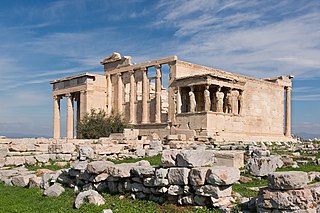
The Erechtheion or Temple of Athena Polias is an ancient Greek Ionic temple on the north side of the Acropolis, Athens, which was primarily dedicated to the goddess Athena.

Wilhelm Dörpfeld was a German architect and archaeologist, a pioneer of stratigraphic excavation and precise graphical documentation of archaeological projects. He is famous for his work on Bronze Age sites around the Mediterranean, such as Tiryns and Hisarlik, where he continued Heinrich Schliemann's excavations. Like Schliemann, Dörpfeld was an advocate of the historical reality of places mentioned in the works of Homer. While the details of his claims regarding locations mentioned in Homer's writings are not considered accurate by later archaeologists, his fundamental idea that they correspond to real places is accepted. Thus, his work greatly contributed to not only scientific techniques and study of these historically significant sites but also a renewed public interest in the culture and the mythology of Ancient Greece.
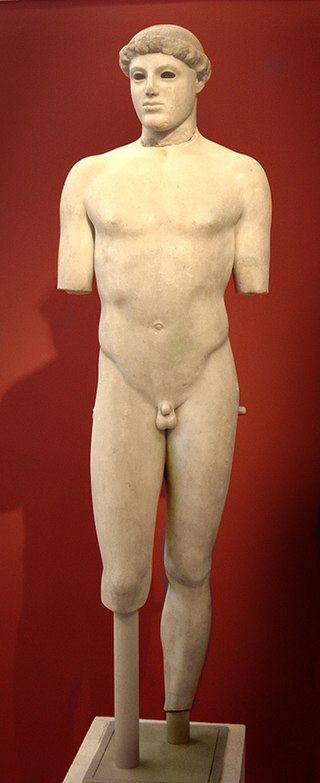
The marble Kritios Boy or Kritian Boy belongs to the Early Classical period of ancient Greek sculpture. It is the first statue from classical antiquity known to use contrapposto; Kenneth Clark called it "the first beautiful nude in art" The Kritios Boy is thus named because it is attributed, on slender evidence, to Kritios, who worked together with Nesiotes or their school, from around 480 BC. As currently mounted, the statue is considerably smaller than life-size at 117 cm, including the supports that replace the missing feet.
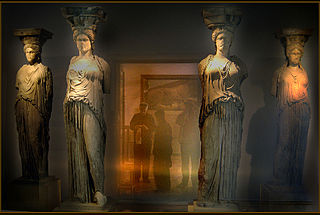
The Old Acropolis Museum was an archaeological museum located in Athens, Greece on the archeological site of Acropolis. It is built in a niche at the eastern edge of the rock and most of it lies beneath the level of the hilltop, making it largely invisible. It was considered one of the major archaeological museums in Athens. Due to its limited size, the Greek government decided in the late 1980s to build a new museum. The New Acropolis Museum is now built at the foot of the Acropolis. In June 2007 the old museum closed its doors so that its antiquities could be moved to their new home, which opened on 20 June 2009.

The Old Temple of Athena or the Archaios Neos was an archaic Greek limestone Doric temple on the Acropolis of Athens probably built in the second half of the sixth-century BCE, and which housed the xoanon of Athena Polias. The existence of an archaic temple to Athena had long been conjectured from literary references until the discovery of substantial building foundations under the raised terrace between the Erechtheion and Parthenon in 1886 confirmed it. While it is uncontroversial that a temple stood on the central acropolis terrace in the late archaic period and was burnt down in the Persian invasion of 480, nevertheless questions of its nature, name, reconstruction and duration remain unresolved.

The Older Parthenon or Pre‐Parthenon, as it is frequently referred to, constitutes the first endeavour to build a sanctuary for Athena Parthenos on the site of the present Parthenon on the Acropolis of Athens. It was begun shortly after the battle of Marathon upon a massive limestone foundation that extended and leveled the southern part of the Acropolis summit. This building replaced a hekatompedon and would have stood beside the archaic temple dedicated to Athena Polias.

The Hekatompedon or Hekatompedos, also known as Ur-Parthenon and H–Architektur, was an ancient Greek temple on the Acropolis of Athens built from limestone in the Archaic period, and placed in the position of the present Parthenon.
Johann (Hans) Hermann Schrader was a German classical archaeologist and art historian.
The Angelitos Athena is an ancient marble statue, which was made around 480–470 BC. The figure, the earliest known depiction of the armed Athena, is an example of the severe style, the transitional style between archaic and classical Greek sculpture which developed after the Persian Wars. Today it is located at the Acropolis Museum under the inventory number 140.
The Peplos Kore is an ancient sculpture from the Acropolis of Athens. It is considered one of the most well-known examples of Archaic Greek art. Kore is a type of archaic Greek statue that portray a young woman with a stiff posture looking straight forward. Although this statue is one of the most famous examples of a kore, it is actually not considered a typical one. The statue is not completely straight, her face is leaned slightly to the side, and she is standing with her weight shifted to one leg. The other part of the statues name, peplos, is based on the popular archaic Greek gown for women. When the statue was found it was initially thought that she was wearing a peplos, although it is now known that she is not.

The Antenor Kore is a Late Archaic statue of a girl (Kore) made of Parian marble, which was created around 530/20 BC.

Panagiotis Kavvadias or Cawadias was a Greek archaeologist. He was responsible for the excavation of ancient sites in Greece, including Epidaurus in Argolis and the Acropolis of Athens, as well as archaeological discoveries on his native island of Kephallonia. As Ephor General from 1885 until 1909, Kavvadias oversaw the expansion of the Archaeological Service and the introduction of Law 2646 of 1899, which increased the state's powers to address the illegal excavation and smuggling of antiquities.

The Achaemenid destruction of Athens was carried out by the Achaemenid Army of Xerxes I during the Second Persian invasion of Greece, and occurred in two phases over a period of two years, in 480–479 BCE.
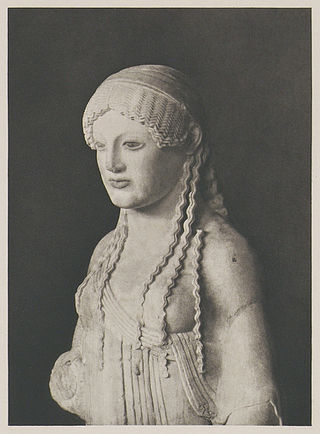
The Euthydikos Kore is a late archaic, Parian marble statue of the kore type, c 490–480 BCE, that once stood amongst the Akropolis votive sculptures. It was destroyed during the Persian invasion of 480 BCE and found in the Perserschutt. It is named after the dedication on the base of the sculpture, “Euthydikos son of Thaliarchos dedicated [me]”. It now stands in the Acropolis Museum.
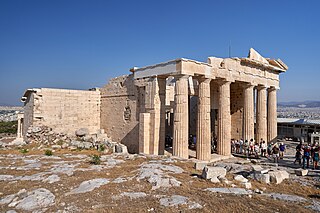
The Propylaia is the classical Greek Doric building complex that functioned as the monumental ceremonial gateway to the Acropolis of Athens. Built between 437 and 432 BCE as a part of the Periklean Building Program, it was the last in a series of gatehouses built on the citadel. Its architect was Mnesikles, his only known building. It is evident from traces left on the extant building that the plan for the Propylaia evolved considerably during its construction, and that the project was ultimately abandoned in an unfinished state.

The Temple of Roma and Augustus was a monopteral circular Ionic temple built on the Acropolis of Athens c. 19 BCE, likely coincident with Augustus' second visit to Athens. The structure was axially aligned with the eastern entrance of the Parthenon, placed 23 m (75 ft) eastward. The temple, which asserted the divinity of Rome and the Imperial cult in the context of the religious centre of the Acropolis, was a propaganda monument erected at a time of tension between Rome and Athens. Its ruins remain on the Acropolis.

Kore 670 is a Late Archaic Greek kore made of Parian marble, created in 520–510 BC, measuring 1.15 cm.

Georg Kawerau was a German architect and archeologist.


























